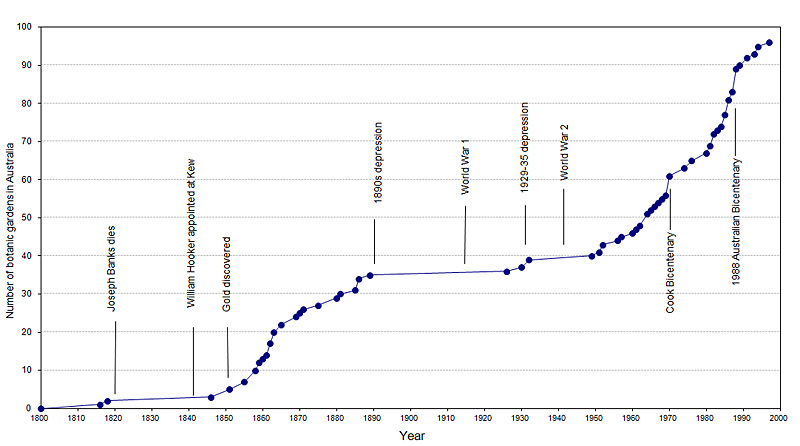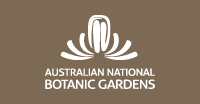A brief history of Botanic Gardens in Australia
Written by Murray Fagg, 2000
The term 'botanic gardens' seems to mean different things to different people, and has meant different things at different times in our history; its use also changes with the context in which we use the term. In many cases we tend to think of a place as a botanic garden if these words appear in its title, regardless of what is inside the fence.
There is some debate about the adjectives 'botanic' vs 'botanical', the former has slipped into disuse in modern English, except in the name of institutions. In Australia 66 gardens have adopted the term 'botanic' in their title while only 10 call themselves 'botanical'.
In one sense a botanic garden can be thought of as a 'living museum', and like natural history museums their role has varied with time and circumstance – they have been academic collections, displays of curiosities, displays of beauty, and educational institutions.
The earliest botanic gardens evolved from 'physic gardens' growing medicinal herbs, usually attached to universities or societies of apothecaries. By the end of the eighteenth century the economic potential of plant introduction and acclimatisation became an important aspect of their role. During the nineteenth century, with the rise in gardening as a leisure activity, we see the scientific and economic role blended with the aesthetic and the love of the exotic in the gardens of Britain and European countries and in their colonies. This was also a time for educating 'the common man' and botanic gardens were seen to have a significant role in this regard.
In Australia we find these sentiments echoed during the 1871 Board of Enquiry into the Melbourne Botanic Gardens:
"Such a Garden would have more than a scientific object – it should also be a place where the whole colony could study horticulture, arboriculture, floriculture and landscape gardening in their most perfect forms – it should especially be a model of careful and thorough cultivation, of well planned scientific effect, and of art skilfully applied to the embellishment of nature."
Little changed with regard to our basic concept of botanic gardens during most of the twentieth century, but by the end of this century a major new role was seen for these gardens – that of conservation.
Thus, by 1989, we have the International Union for the Conservation of Nature (IUCN) defining the characteristics of the ideal botanic gardens:
· A reasonable degree of permanence
· Open to the public
· Adequate labelling of the plants
· Communication of information to other gardens, institutions and the public
· An underlying scientific basis for the collections
· Proper documentation of the collections, including wild origin
· Monitoring the plants in the collections
· Exchange of seeds or other materials with other botanic gardens, arboreta or research stations
· Undertaking of scientific or technical research on plants in the collections
· Maintenance of research programs in plant taxonomy in associated herbaria
The development of botanic gardens in Australia
Sir Joseph Banks was the first, though unofficial director of the Royal Botanic Gardens in Kew, and was instrumental in establishing key botanic gardens in the British colonies, promoting both their scientific role and their economic benefits in transferring and acclimatising plants. Only two botanic gardens were established in Australia during Banks' lifetime, those at Sydney and Hobart. Following Banks' death in 1820 both the Kew Gardens and those in the colonies went into decline. The birth of the Victorian era in 1837 and the appointment of Sir William Hooker as the first real Director of Kew Gardens in 1841 saw a steady rise in both the concept of Empire and the role of botanic gardens.
A Royal Commission under the Chairmanship of Dr John Lindley in 1838 into the declining Kew Gardens had clearly spelt out that Kew must have an imperial as well as a domestic role. William Hooker, and later his son Joseph Hooker who followed him as Director of Kew, seized on these recommendations and developed considerable influence in the British Colonial Office, striving to popularise botany at home and throughout the Empire. Although the botanic gardens established in the colonies were technically independent of Kew they were very much dependent on it for advice, books, plants and protection against attack from government officials and uneducated settler colonists.
Kew's expanding influence in the colonies corresponded with the discovery of gold in Australia, providing the wealth required to establish new botanic gardens. Our towns and cities were comparatively young and public land was often available near their centres without great cost to the public purse.
In 1888, the Picturesque Atlas of Australasia, published for our centenary, stated:
"All great cities of Australia, by an instinct as artistic as it is wise, have made excellent provision for botanic gardens. Sydney led the way, and the example has been universally followed. In no instance has any public money been grudged for the adornment and maintenance of these delightful retreats. The different cities vie with one another in the care they take of this portion of their public property. In no two cases do the sites resemble each other, and each great botanic garden has its specialties."
By the end of the nineteenth century there were thought to be about 380 botanic gardens in the world, over half of these were in Britain and Europe (205 or 54%), while 30% (115) were in the British colonial empire. Australia, with 30 botanic gardens, had about 8% of the world's botanic gardens.
The first half of the twentieth century was a low point for the establishment of botanic gardens in Australia – wars and the depression were not conducive to these activities.
The post-war economic boom in Australia once again brought wealth, but this time it was not Kew that was influencing the emerging gardens but a new found confidence in things Australian, especially the use of Australian plants. Thistle Harris' book Australian Plants for the Garden in 1953 broke new ground; Edna Walling's advocacy of including native plants in landscaping, and the establishment of the Society for Growing Australian Plants (SGAP) in 1958 were symptomatic of this trend and influential in shaping the next wave of botanic gardens.
There were two points of focus for the post-war development of botanic gardens in Australia; the first was the 1970 bicentenary of Captain Cook's arrival, and the second was the 1988 bicentenary of European settlement. In both instances government grants were available for projects such as the establishment of public gardens.

During the 1980s the groundswell of public opinion on matters to do with conservation started to make an impact on the role of botanic gardens. In 1989 the Botanic Gardens Conservation Strategy was published jointly by three influential bodies: Botanic Gardens Conservation International (BGCI), the International Union for the Conservation of Nature (IUCN) and the World Wide Fund for Nature (WWF). Today more and more Australian botanic gardens, especially those newly established, recognise that they can play a range of diverse roles in conservation and environmental education.
Not only is there a role for them in the conservation of biodiversity, but international conventions resulting from the Earth Summit in Rio de Janero in 1992 are forcing botanic gardens to re-evaluate the way they operate. This is especially the case with regard to their role in moving plants and seeds around the world and the ethical, political and economic aspects associated with the 'ownership' of the rich store of genetic resources they hold in their collections.
The exact number of botanic gardens in Australia depends a bit on how you define 'botanic gardens' and at what point in their development they are included in the list. We know that there are more than 100 gardens in Australia with some claim to such a title.
By the end of the twentieth century it was estimated that there were about 1,600 botanic gardens in the world. Australia, with about 100, has about 6.2% of those.
Written by Murray Fagg for the book:
Lockwood, Leslie; Wilson, Jan and Fagg, Murray (2001) 'Botanic Gardens of Australia - A Guide to 80 Gardens',
New Holland Publishers, Sydney, 176 pp.
![An Australian Government Initiative [logo]](/images/austgovt_brown_90px.gif)







